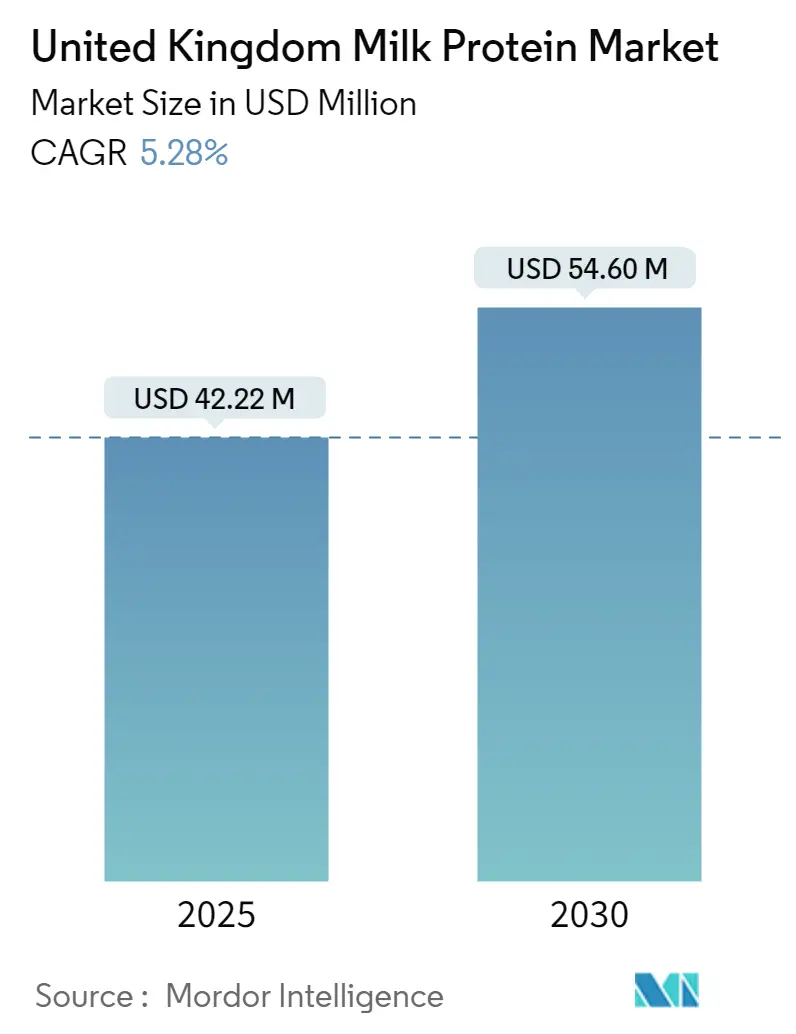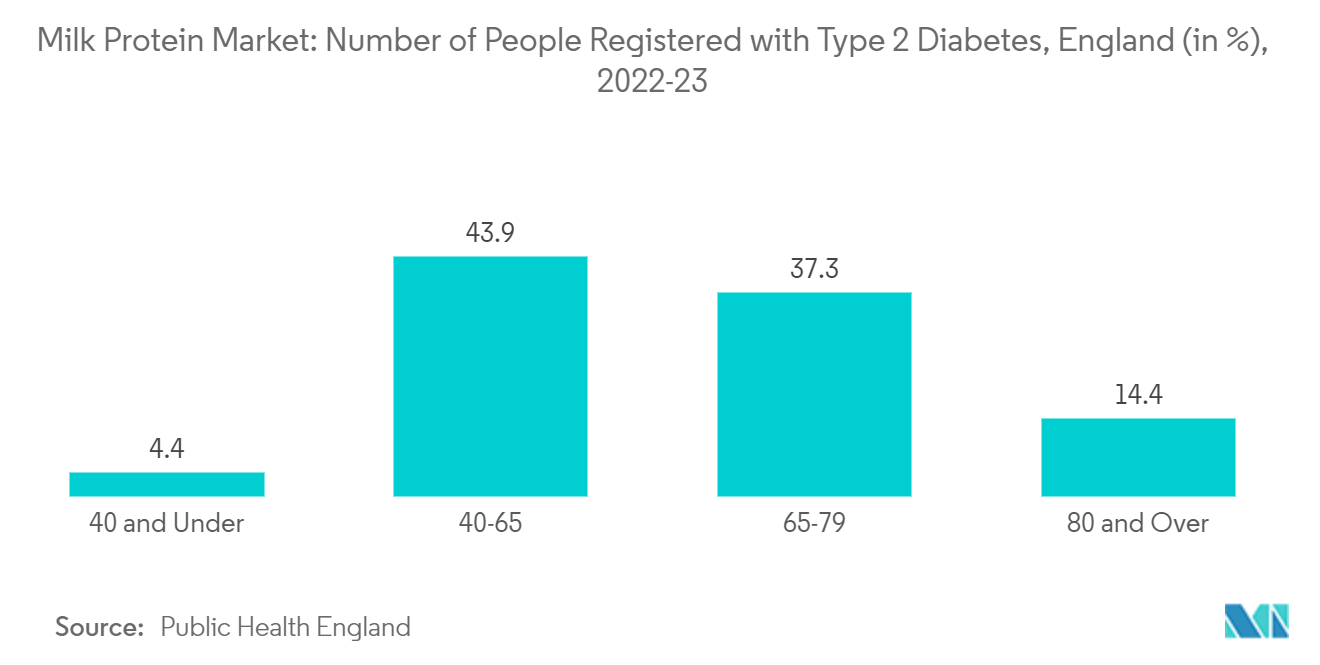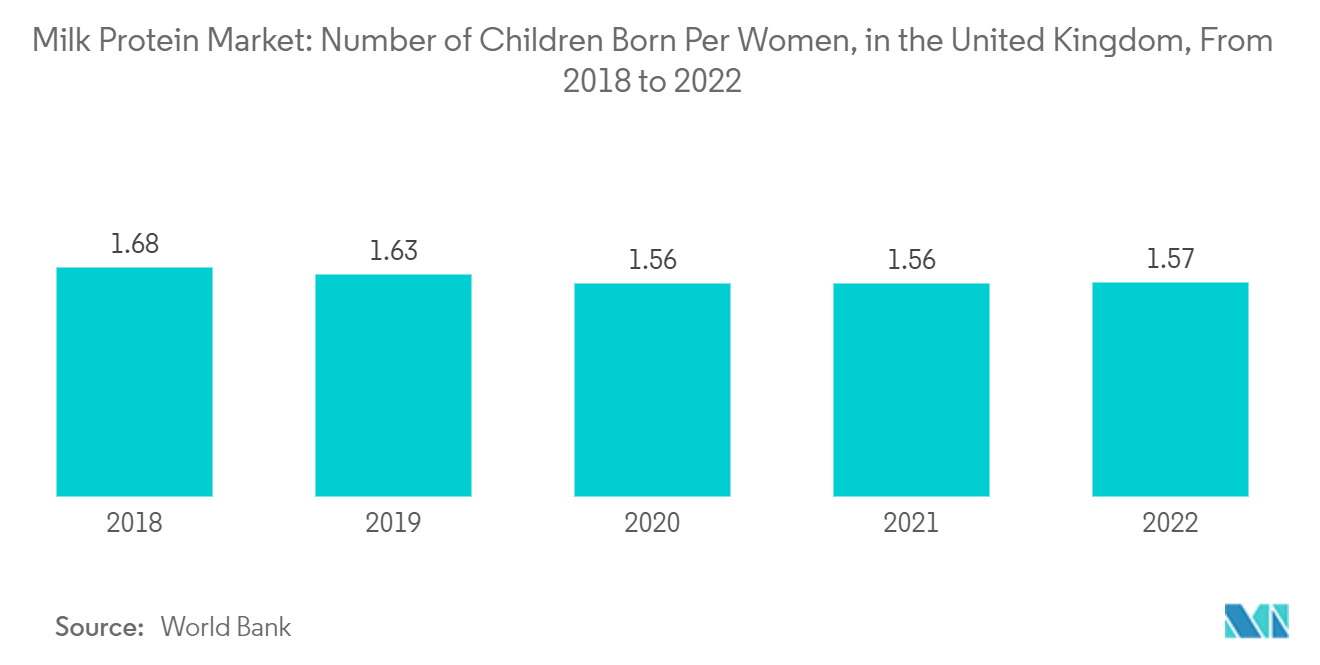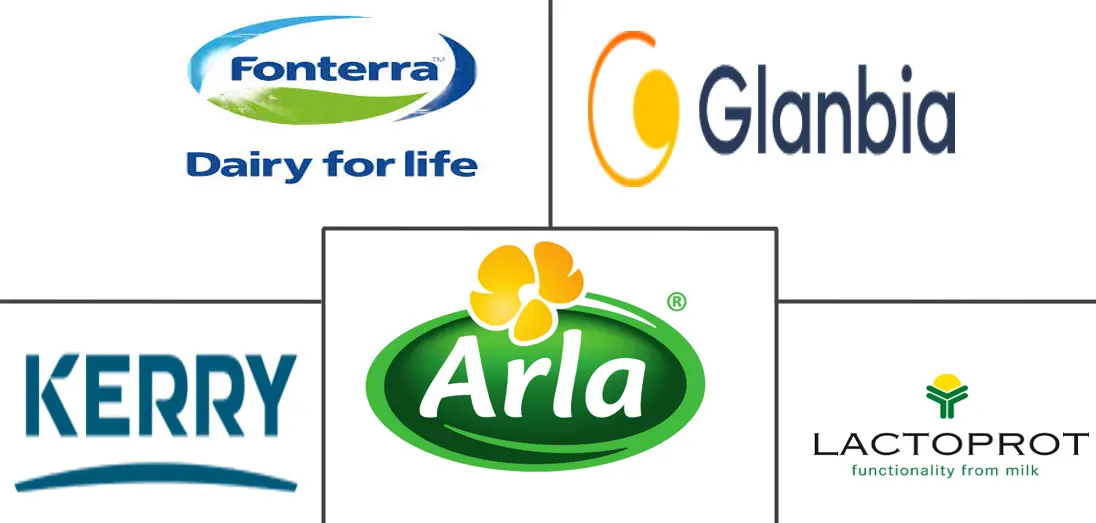
United Kingdom Milk Protein Market Analysis by Mordor Intelligence
The United Kingdom Milk Protein Market size is estimated at USD 42.22 million in 2025, and is expected to reach USD 54.60 million by 2030, at a CAGR of 5.28% during the forecast period (2025-2030).
Milk proteins are highly valued for their nutritional content, versatility, and functional properties in various applications. Milk proteins are essential ingredients in numerous products across the food and beverage industry, utilized for their ability to enhance texture, flavor, and nutritional value. They are widely used in sports nutrition products, such as protein powders and bars, due to their high-quality protein content that supports muscle repair and growth. Additionally, milk proteins are integral to the production of dairy products like cheese and yogurt and are also used in infant formulas, offering essential amino acids crucial for early development.
Consumers in the United Kingdom are increasingly seeking healthier food options because of urbanization, lifestyle changes, and the rising number of women in the workforce. The demand for protein-fortified foods is on the rise to meet the daily dietary needs of consumers. Additionally, the growing elderly population in the United Kingdom is fueling the need for products that address their specific nutritional requirements, such as milk proteins. Older individuals require higher protein intake to preserve muscle mass, strength, and overall well-being. Milk protein, being a high-quality and easily digestible source of essential amino acids, is well-suited to meet these needs. For instance, according to the World Bank’s data from 2022, 19.17% of the population in the United Kingdom is aged 65 and above.
United Kingdom Milk Protein Market Trends and Insights
The Milk Protein Concentrates Segment Accounts for the Largest Share in the Market
Milk protein concentrates are popular due to their balanced content of proteins and other nutrients like minerals, which make them versatile for a range of applications from sports nutrition to fortified dairy products. Their moderate protein concentration makes them ideal for consumers looking for balanced nutrition without the intensity of higher protein products.
Various factors like longer shelf life, convenience, rich flavor and texture, versatility in cooking, economic value, and easy storage and transportation have also been supporting the usage and growth of milk protein concentrates in the country.
Moreover, the increasing prevalence of obesity, diabetes, and other lifestyle diseases is catalyzing the demand for nutritional food products in the United Kingdom. People with diabetes need meticulously planned diets that regulate blood sugar levels and offer sufficient nourishment. Milk protein concentrates have low carbohydrate content and high protein levels, making them suitable for diabetic-friendly diets. Additionally, MPCs are extensively utilized in clinical nutrition products that are frequently prescribed or recommended for diabetic patients. For instance, as per Public Health England, there were more than 3.7 million registered diabetics in England between 2022 and 2023.

Increasing Demand for Supplements Driving the Market
There is a growing interest in health, fitness, and wellness among consumers in the United Kingdom. This trend is driving demand for high-quality protein supplements to support muscle growth, recovery, and overall health. Sports nutrition products are increasingly being formulated to offer additional functional benefits such as enhanced digestion, improved absorption, and added vitamins and minerals. Milk proteins are often included in these formulations due to their versatile nature.
In addition, there is a growing consumer preference for clean-label and natural products that are free from artificial additives and preservatives. Milk protein supplements that meet these criteria are particularly popular among health-conscious consumers.
Furthermore, milk proteins are easily digestible and commonly chosen for infant formulas to ensure efficient absorption and utilization of nutrients. Formulas with a higher whey-to-casein ratio are considered more suitable for infants. Milk protein contributes to various health advantages for infants, such as enhanced growth rates, strengthened immune systems, and the establishment of a healthy gut microbiome. These advantages establish milk proteins as a favored component in infant formula. As a result, the increasing birth rates in the United Kingdom significantly bolster the milk proteins market. For example, as per the World Bank, the fertility rate in 2022 stood at approximately 1.57 children per woman.

Competitive Landscape
The UK milk proteins market is fragmented, with the presence of local and international players. The major players in this market are Arla Foods Group, Fonterra Co-operative Group Limited, Glanbia PLC, Kerry Group PLC, and Lactoprot Deutschland GmbH. The major players are focusing on product development, mergers and acquisitions, partnerships, and expansions to strengthen their position in the market. High investments in R&D activities and product innovations have led them to gain a major market share.
United Kingdom Milk Protein Industry Leaders
Arla Foods Group
Fonterra Co-operative Group Limited
Glanbia PLC
Kerry Group plc
Lactoprot Deutschland GmbH
- *Disclaimer: Major Players sorted in no particular order
.webp)
Recent Industry Developments
- April 2024: Arla Foods Ingredients acquired Volac's Whey Nutrition Business. The UK-based Volac Group specializes in turning whey into ingredients for sports nutrition, with its by-products being sold for food and animal nutrition.
- February 2024: SCI-MX introduced a new transparent whey protein isolate to its range of high-protein products. With 21 g of protein, it comes in Tropical Island Punch and Apple & Blackcurrant flavors.
- January 2024: UK food and drink manufacturer Aimia Foods entered the sports nutrition market with the introduction of a range of clear whey protein powders called Isovibe. Isovibe is available in four flavors: peach & raspberry, cherry & apple, lemon & lime, and mango & passionfruit.
United Kingdom Milk Protein Market Report Scope
Milk protein is a type of protein that is derived from filtered milk and is formed from whey and casein proteins.
The UK milk proteins market is segmented by form, type, and end user. Based on form, the market is segmented into concentrates and isolates. Based on type, the market is segmented into casein and whey proteins. Based on end user, the market is segmented into animal feed, food and beverages, and supplements. The food and beverage segment is further sub-segmented into bakery, beverages, breakfast cereals, condiments and sauces, dairy and dairy alternative products, RTE and RTC food products, and snacks. The supplements segment is further sub-segmented into baby food and infant formula, elderly nutrition and medical nutrition, and sports and performance nutrition.
For each segment, the market sizing and forecasts have been done based on value (USD).
| Concentrates |
| Isolates |
| Casein |
| Whey Proteins |
| Animal Feed | |
| Food and Beverages | Bakery |
| Beverages | |
| Breakfast Cereals | |
| Condiments and Sauces | |
| Dairy and Dairy Alternative Products | |
| RTE and RTC Food Products | |
| Snacks | |
| Supplements | Baby Food and Infant Formula |
| Elderly Nutrition and Medical Nutrition | |
| Sports and Performance Nutrition |
| Form | Concentrates | |
| Isolates | ||
| Type | Casein | |
| Whey Proteins | ||
| End User | Animal Feed | |
| Food and Beverages | Bakery | |
| Beverages | ||
| Breakfast Cereals | ||
| Condiments and Sauces | ||
| Dairy and Dairy Alternative Products | ||
| RTE and RTC Food Products | ||
| Snacks | ||
| Supplements | Baby Food and Infant Formula | |
| Elderly Nutrition and Medical Nutrition | ||
| Sports and Performance Nutrition | ||
Key Questions Answered in the Report
How big is the United Kingdom Milk Protein Market?
The United Kingdom Milk Protein Market size is expected to reach USD 42.22 million in 2025 and grow at a CAGR of 5.28% to reach USD 54.60 million by 2030.
What is the current United Kingdom Milk Protein Market size?
In 2025, the United Kingdom Milk Protein Market size is expected to reach USD 42.22 million.
Who are the key players in United Kingdom Milk Protein Market?
Arla Foods Group, Fonterra Co-operative Group Limited, Glanbia PLC, Kerry Group plc and Lactoprot Deutschland GmbH are the major companies operating in the United Kingdom Milk Protein Market.
What years does this United Kingdom Milk Protein Market cover, and what was the market size in 2024?
In 2024, the United Kingdom Milk Protein Market size was estimated at USD 39.99 million. The report covers the United Kingdom Milk Protein Market historical market size for years: 2019, 2020, 2021, 2022, 2023 and 2024. The report also forecasts the United Kingdom Milk Protein Market size for years: 2025, 2026, 2027, 2028, 2029 and 2030.
Page last updated on:
United Kingdom Milk Protein Market Report
Statistics for the 2025 United Kingdom Milk Protein market share, size and revenue growth rate, created by Mordor Intelligence™ Industry Reports. United Kingdom Milk Protein analysis includes a market forecast outlook for 2025 to 2030 and historical overview. Get a sample of this industry analysis as a free report PDF download.



